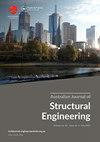Finite element formulation of Timoshenko tapered beam-column element for large displacement analysis based on the exact shape functions
IF 0.9
Q4 ENGINEERING, CIVIL
Australian Journal of Structural Engineering
Pub Date : 2022-05-29
DOI:10.1080/13287982.2022.2070958
引用次数: 2
Abstract
ABSTRACT A numerical formulation was carried out in this paper to produce the tangent stiffness matrix for two-nodal tapered Timoshenko beam-column elements for geometrically nonlinear analysis. The proposed solution is based on the exact shape functions and their derivatives describing the non-uniformity of the element properties. The section properties were presented as exponential functions with tapering indices to illustrate the variations in section properties along the tapered element length. The model is applicable for elements with different solid and hollow cross-sections. The proposed formulation is embedded into a Visual Basic code to carry out the analysis accompanied by many examples for validating its accuracy and efficiency. The model results are compared with those of commercial software and cited references that showed high accurate results with a small number of elements.基于精确形函数的大位移分析的Timoshenko锥形梁柱单元有限元公式
本文建立了用于几何非线性分析的两节点锥形Timoshenko梁柱单元的切向刚度矩阵的数值表达式。所提出的解决方案是基于精确的形状函数及其导数来描述元件性质的非均匀性。截面特性以带锥形指标的指数函数表示,以说明截面特性沿锥形单元长度的变化。该模型适用于不同实心截面和空心截面的构件。所提出的公式被嵌入到Visual Basic代码中来执行分析,并附有许多示例来验证其准确性和效率。将模型结果与商业软件和引用文献的结果进行了比较,结果表明,使用较少的元素,结果精度较高。
本文章由计算机程序翻译,如有差异,请以英文原文为准。
求助全文
约1分钟内获得全文
求助全文
来源期刊

Australian Journal of Structural Engineering
ENGINEERING, CIVIL-
CiteScore
2.50
自引率
0.00%
发文量
31
期刊介绍:
The Australian Journal of Structural Engineering (AJSE) is published under the auspices of the Structural College Board of Engineers Australia. It fulfils part of the Board''s mission for Continuing Professional Development. The journal also offers a means for exchange and interaction of scientific and professional issues and technical developments. The journal is open to members and non-members of Engineers Australia. Original papers on research and development (Technical Papers) and professional matters and achievements (Professional Papers) in all areas relevant to the science, art and practice of structural engineering are considered for possible publication. All papers and technical notes are peer-reviewed. The fundamental criterion for acceptance for publication is the intellectual and professional value of the contribution. Occasionally, papers previously published in essentially the same form elsewhere may be considered for publication. In this case acknowledgement to prior publication must be included in a footnote on page one of the manuscript. These papers are peer-reviewed as new submissions. The length of acceptable contributions typically should not exceed 4,000 to 5,000 word equivalents. Longer manuscripts may be considered at the discretion of the Editor. Technical Notes typically should not exceed about 1,000 word equivalents. Discussions on a Paper or Note published in the AJSE are welcomed. Discussions must address significant matters related to the content of a Paper or Technical Note and may include supplementary and critical comments and questions regarding content.
 求助内容:
求助内容: 应助结果提醒方式:
应助结果提醒方式:


